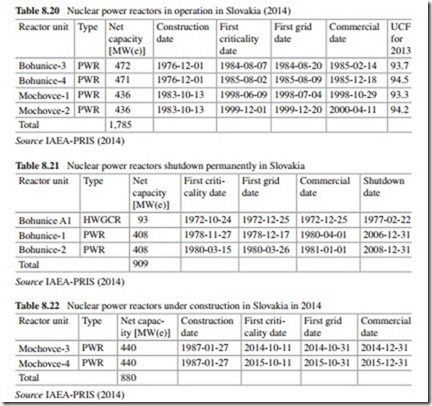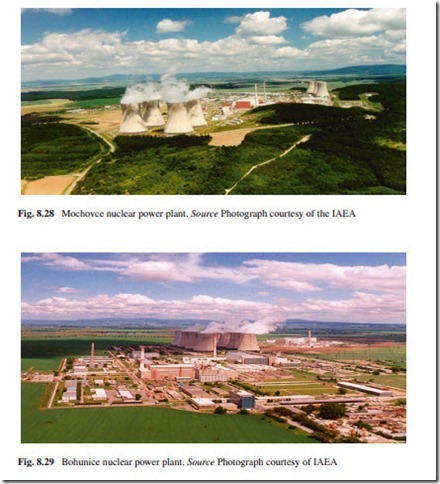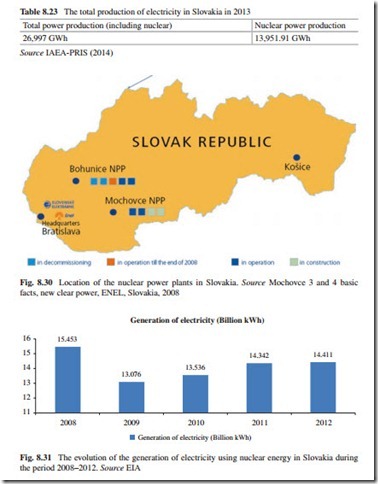Slovakia
According to the IAEA, the new energy policy of the Slovak Republic was approved by a resolution of the Slovak government adopted in 2009.19 Long-term energy pol- icy is based on the permanent reduction of energetic intensity of the economy. The objective is formulated so, thus its realization provides an accessibility of the energy for all end customers in real time and on the economically effective principle.
The new energy policy is a strategic document defining the basic objectives and framework of the energy sector development in the long-term until the year 2035. It is part of the national economic strategy of the Slovak Republic, as ensuring sustainable economic growth and competitiveness is conditioned by reliable energy supply.
The energy policy of Slovakia is in compliance with the EU Energy Policy of 2007 and is based on the fundamental European objectives, as defined in document “Energy 2020” for the energy sector. The document emphasizes the optimal use of domestic energy sources and low-carbon technologies, such as renewable energy sources and nuclear energy. An important milestone for the Slovak energy sector was the implementation of the third energy package of the European parliament and council compose by the Regulation (EC) No. 713/2009 of the European parlia- ment and of the council of July 13, 2009, establishing an Agency for Cooperation of Energy Regulators; Regulation (EC) No. 714/2009 of the European parlia- ment and of the council of July 13, 2009, on conditions for access to the net- work for cross-border exchanges in electricity and repealing Regulation (EC) No. 1228/2003; Regulation (EC) No. 715/2009 of the European parliament and of the council of July 13, 2009, on conditions for access to the natural gas transmission networks and repealing Regulation (EC) No. 1775/2005; Directive 2009/72/EC of the European parliament and of the council of July 13, 2009, concerning common rules for the internal market in electricity and repealing Directive 2003/54/EC; Directive 2009/73/EC of the European parliament and of the council of July 13, 2009, concerning common rules for the internal market in natural gas and repeal- ing Directive 2003/55/EC, the Directive 2003/54/EC of the European parliament and the council of June 26, 2003, concerning common rules for the internal market in electricity and repealing Directive 96/92/EC, the adoption of the Energy Act of 2001 and the Act on Regulation in Network Industries at the end of July 2012.
It is important to highlight that Slovakia has a balanced energy mix, in which the share of fossil fuels and nuclear fuel is roughly equal. The shares of individual sources on the gross domestic consumption in 2011 were the following:
• Natural gas: 26 %;
• Nuclear fuel: 22 %;
• Coal: 22 %;
• Crude oil: 21 %;
• Renewable energy sources, including hydropower plants: 9 %.
Gross domestic energy consumption of Slovakia has a long downward trend with a growth of gross domestic product. The decrease in gross domestic consumption occurred mainly as a result of industry restructuring, wider application of the principles of energy efficiency by introducing modern production technologies with lower energy intensity, insulation of buildings, switching of consumers to low- energy appliances, and saving as a result of price deregulation.
The strategic objective of the energy policy of the Slovak Republic is to achieve competitive and sustainable energy sector, ensuring secure, reliable, and efficient sup- ply of all forms of energy at affordable prices, taking into account consumer protection and sustainable development. The pillars of the new energy policy are given below:
• Energy security;
• Energy efficiency;
• Competitiveness;
• Sustainable development.
The following are the priorities of the new energy policy to support these pillars:
• For the enhance of energy security the priorities are: (a) Diversification of energy sources and transport routes; (b) Strengthening regional cooperation;
(c) Improving nuclear safety and reliability; (d) The use of domestic resources, renewable sources, and secondary energy sources; (e) Balanced electricity generation and consumption; (f) Development of smart grids in a cost-effective manner; and (g) Creating a stable legislative framework in the field of energy security:
• For the increase of energy efficiency, the priorities are: (a) The reduction of
energy intensity to the EU level; (b) The processing of a complex analysis of the potential of energy savings for individual sectors of the national economy by 2030; (c) An increase in the allocation of funds from the EU funds for projects in the field of energy efficiency, preference to technologies with high efficiency;
(d) Optimal development of energy infrastructure; and (e) Efficiency gains mainly in the public sector;
• For ensuring competitiveness of the energy sector, the priorities are: (a) Stable legislative framework; (b) Well-functioning energy market; and (c) Competitively priced energy;
• For the achievement of the objective of sustainable development of energy sector, the priorities include: (a) Increasing the proportion of low-carbon and car- bon-free electricity generations; (b) Increasing the share of renewable sources of energy in heat production; and (c) The use of nuclear energy as a major source of carbon-free source of electricity.
Slovakia adopted, inter alia, in the field of reducing greenhouse gas emissions a reduction target from the Kyoto Protocol, which is a commitment to reduce the aggregate greenhouse gas emissions in the period 2008–2012 by 8 % when com- pared to the year 1990. In the first period of the Kyoto Protocol, Slovakia meets this objective without much difficulty.
Nuclear Power Reactors Operating in Slovakia
The Slovak Republic is substantially dependent on import of primary power sources in order to satisfy 90 % of inland consumption. The most important import items of the primary power sources represent the crude oil, ground gas, black coal, and nuclear fuel from the Russian Federation.
The production of nuclear power plants participates markedly in the cover- age of the overall consumption of electricity in the Slovak Republic. At present, there are four units (equipped with nuclear reactors WWER-440) in operation in Slovakia located in two sites: at Jaslovské Bohunice (2 units) and Mochovce (2 units) (see Table 8.20). The net capacity of the four units is 1,815 MWe.
On December 31, 2006, and December 31, 2008, the operation of the two units was shutdown in accordance with the commitment made by the Slovak Republic for the EU Accession Treaty. Altogether 909 MWe was put out of service (see
Table 8.21). The closure of Units 3 and 4 of the Bohunice nuclear power plant has been foreseen for 2025.
At the same time, there are two units under construction at the Mochovce nuclear power plant site, schedule for entry into operation the first unit at the end of 2014 and the second at the end of 2015 (see Table 8.22).
Plans for the construction of new nuclear power reactors were outlined in the October 2008 Energy Security Strategy of the Slovak Republic. The strategy aimed to maintain the proportion of electricity generated by nuclear power plants at around 50 % through the following measures:
• Completion of Mochovce Units 3 and 4 by 2013 (880 MWe gross) (see Fig. 8.28);
• Uprates at Bohunice V2 and Mochovce Units 1 and 2 by 2010 (180 MWe gross) (see Fig. 8.29);
• Uprates at Mochovce Units 3 and 4 by 2015 (60 MWe gross);
• Construction of a new reactor block at Bohunice by 2025 (1,200 MWe gross).
In addition, around 2025, when the two V2 units will have reached 40 years of operation, the strategy calls for either life extension of the both units or for the construction of 1,200 MWe of new nuclear capacity at Kecerovce in the East of the country.
The plans for the construction of a new nuclear power reactor at Bohunice with a capacity of 1,000–1,600 MWe were announced in April 2008, probably using Western technology to enable MOX fuel. In December 2008, Czech utility (CEZ) announced it has the 49 % of joint venture partner for the construction of these new units, with state-owned Javys holding 51 %. CEZ reportedly paid €117 mil- lion for its Javys’ share. The formal JESS (Jadrová Energetická Spolocˇnosť Slovenska, Slovakia Nuclear Energy Company) joint venture agreement was signed in May 2009. Financing was to be finalized in 2011 and construction was planned to start in 2013, the expected cost being €3.32 billion (for a 1,200 MWe unit). Following an 18-month feasibility study, there was to be a call for tenders, AREVA, and WESTINGHOUSE being considered the main possibilities, and in September 2012 JESS reported that the technology offered by six vendors20 met the requirements for one or two reactors at Bohunice.
In August 2010, the newly elected center-right government said it was keen for the Bohunice project to proceed, but would not offer any financial support for it. It was not expected to be operational before 2025, but the Minister of Economy said in May 2011 that it could be operational by 2020. A new left-wing government in April 2012 pledged to speed up the project and to decide upon proceeding early in 2013, as well as pushing completion of Mochovce Units 3 and 4, apparently delayed by the need to incorporate modifications due to EU stress tests.
CEZ wants to sell its stake in JESS, reportedly for €110 million, in order to concentrate on its Temelin project, and ROSATOM has been exploring the pros- pect of being both technology provider and investor in this unit. In April 2013, CEZ offered its JESS share to ROSATOM, and the Slovak Economy Ministry said that it would be happy to accept this change, with ROSATOM Overseas buying it and building a 1,200 MWe reactor from about 2021. It seeks a guaranteed long- term electricity price of €60–70 per MWh, which the Economy Ministry is unwilling to provide, and possibly a build-own-operate arrangement. ROSATOM in January 2014 said it remained interested if the Slovak government could guarantee profitability in some way, and negotiations with CEZ continued.
Preliminary works on the project are proceeding. JESS has arranged for the Environmental Impact Assessment to be undertaken by AMEC by mid-2016. Purchase of land was almost complete in 2013. The nuclear power reactors cur- rently in operation in Slovakia were producing electricity at half the average cost for all Slovak energy sources. For this reason, the early closure of the two nuclear power reactors before Mochovce Units 3 and 4 enter into commercial operation in the coming months could leave the country short of power.
Generation of Electricity Using Nuclear Energy
The total production of electricity in Slovakia using nuclear energy in 2013 is shown in Table 8.23. The participation of nuclear energy in the generation of electricity in 2014 in Slovakia was 51.68 %.
The location of the Slovak nuclear power plants is shown in Fig. 8.30.
The evolution of the generation of electricity using nuclear energy in Slovakia during the period 2008–2012 is shown in Fig. 8.31.
According to Fig. 8.31, the generation of electricity using nuclear energy in Slovakia during the period 2008–2012 decreased 6.8 %. It is expected that the use of this type of energy source for the generation of electricity in Slovakia will continue decreasing during the coming months until Units 3 and 4 of Mochovce nuclear power plants enter into commercial operation.
The Public Opinion
In a poll carried out by the independent agency GfK in 2007, over two-thirds of the Slovak population and more than 87 % of the population living in 10 km area around the Mochovce nuclear power plant are in favor of the completion of Units 3 and 4. The main opposition related to the use of nuclear energy for electricity production in Slovakia comes from neighboring Austria. This last country has adopted a law prohibiting the use of nuclear energy for electricity production and is against the use of EU funds for the support of the construction of new nuclear power reactors in other countries as well.
According to press information, however, the completion of the Units 3 and 4 at the Mochovce nuclear power plant meets certain public opinion opposition. Apart from traditional antinuclear-oriented Austrian neighbor, objections were raised also by Green Fraction at the European parliament. They said that “Mochovce design and its equipment are not based on accident and earthquake safety considerations.” In addition, they claim that “Mochovce construction is far too advanced to be retrofit- ted to comply with international safety standards.” At the same time, ÚJD chairperson Marta Ziakova says “she cannot imagine the conditions under which Mochovce 3 and 4 building permit could be taken away. The construction is under permanent surveillance of Slovakian nuclear authorities.” The two units will not be built according to the original plan and will be equipped with modern systems in line with the current inter- national safety regulations. Numerous evaluations of foreign institutions, including the IAEA and WANO, confirmed “that the safety of Slovak reactors is at the level of operators in Western Europe,” said the Mochovce operator spokesman Juraj Kopriva.
Looking Forward
According to Morales Pedraza (2012), at the end of October 1995, the Slovak Republic and Russia signed an agreement for the conclusion of Units 3 and 4 of Mochovce nuclear power plant. In addition, a loan of US$150 million for com- pleting Unit 3 will be provided by Russia as well as the supply fuel for the plant and will reprocess the spent nuclear fuel. The cost of completing Units 3 and 4 is estimated at US$1.14 billion. The Italian company ENEL had also agreed to invest around €1.8 billion with this purpose. With the entry into operation of these two units, the nuclear capacity of the country will be increased in 880 MWe. The Slovakian authorities have already invested €576 million in these two units.
However, and despite of what have been said in the previous paragraphs, it is important to highlight the following: The extent of structural improvements of Mochovce Units 3 and 4 is limited because, in 1993, when construction was stopped, already 70 % of civil construction was completed and 30 % of the equipment had been supplied, among them the reactor vessel and steam generators, which were partially installed, have been mothballed and are stored at the plant. The structural limitations mainly concern the confinement structures and the possibility of physical separation of safety systems. Neither the reactor building, nor the bubble condenser is resistant against external events, such as an airplane crash or a missile attack.
On the other hand, it is important to single out that Units 3 and 4 do not have containment, only a confinement with a bubble condenser to limit the pressure from large pipe ruptures. The tests showed the functioning of the bubble con- denser for design basis accidents and some severe accidents, but not all. Seismic design has to be proven in relation to the earthquake risk at the site, because this is a weak point of all WWER 440/213 units. Moreover, seismic evaluation and seismic design have evolved fundamentally in recent years. It is unclear whether Mochovce Units 3 and 4 can meet the latest seismic design standards of the IAEA. In June 2009, the Czech company Skoda JS and the Slovak company SE signed in Bratislava a contract to conclude the construction of Units 3 and 4 of the Mochovce nuclear power plant. The contract was signed for US$517 million for the supply of important equipment, including part of the instrumentation and control system. The heavy equipment for these two units was manufactured by Skoda and surrendered to the nuclear power plant in the 1980s, but the project was stopped.
Despite of the difficulties in the operation of the first nuclear power reactor at Bohunice and the strong opposition of the Austrian authorities to the use of nuclear energy for electricity generation in Slovakia, the government is considering the possibility of building a fifth unit at the Mochovce nuclear power plant and also new units at the Bohunice nuclear power plant, or in a new site located in the Eastern part of the country (Kecerovce).
At the same time, it is important to highlight that Slovakia and the Czech Republic have created a mixed company to build new nuclear power reactors at Bohunice, with the purpose of replacing the two Slovak units that were stopped as a condition to the access of the country to the EU. After a feasibility study carried by the competent authorities of both countries, it was decided that the construction of these new units could be carried out without major difficulties. This agreement also opens the possibility to enlarge Temelin nuclear power plant in the Czech Republic, as it was foreseen initially, with the construction of other two nuclear power reactors of WWER-1000 type similar to the ones already operating in this site.
Summing-up can be stated that the government’s list of priority power projects for the future shows, 1,200 MWe for Bohunice for commissioning by 2025 at a cost of €3 billion, the possible construction of a 1,200 MWe nuclear power plant at Kecerovce after the closure of Bohunice Units 3 and 4 in 2025 at a cost of €3.5 billion. Preparation for decommissioning Units 3 and 4 will begin in 2012. It is expected that this work will be done in 13 years at an estimated cost of about €500 million.


